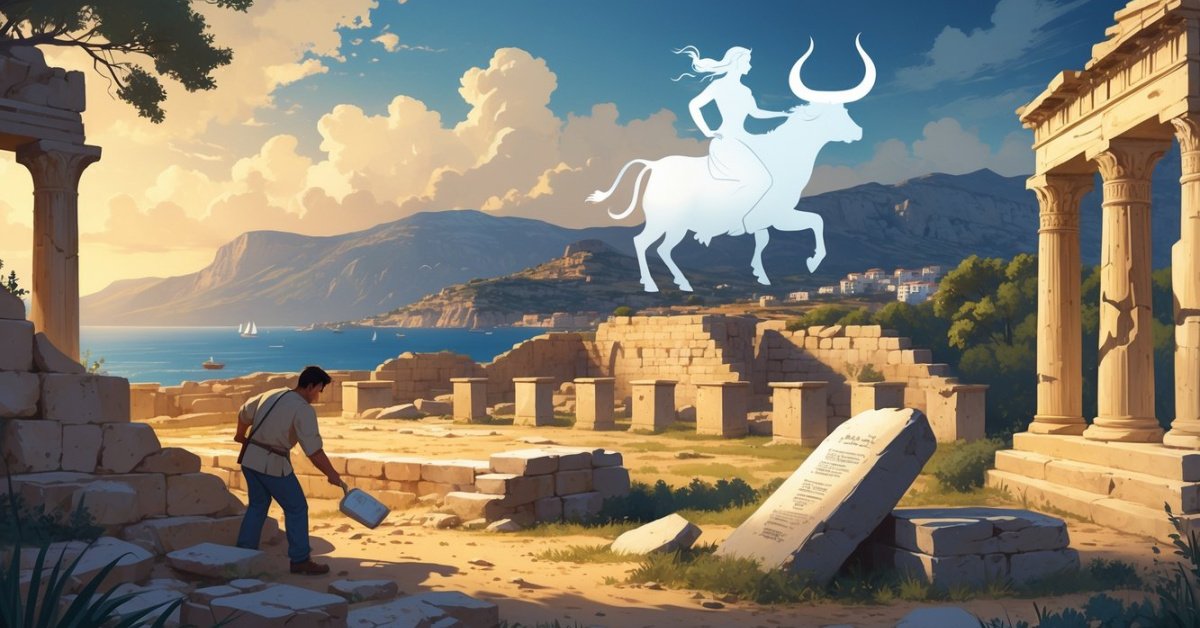Cape Verde is a small island nation in the Atlantic Ocean with a long and complex past. Tales of the first Portuguese settlers and secrets beneath the streets of Cidade Velha hint at each island’s unique history.
Many questions about pirate activity, lost slave histories, and hidden documents still puzzle locals and historians.
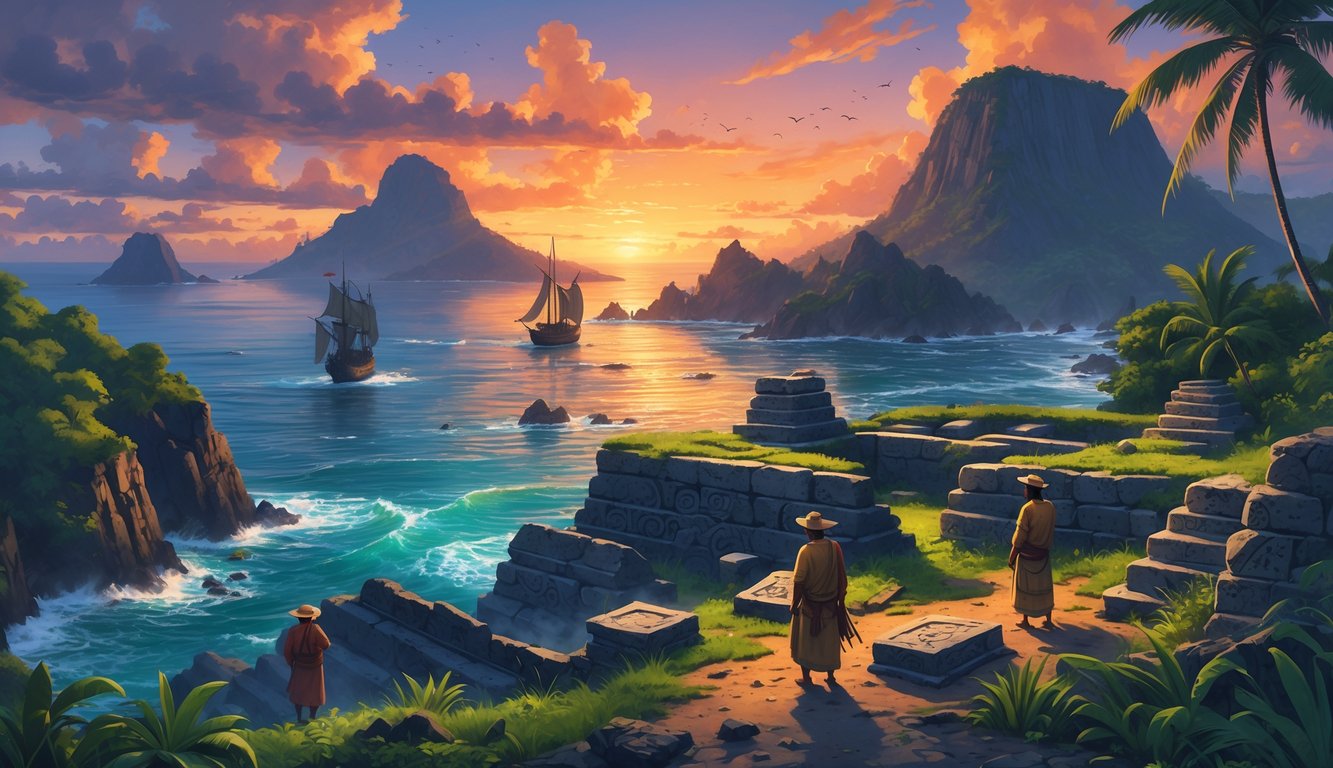
Different cultures have left their mark on Cabo Verde. Not all stories have been explained.
New archaeological digs uncover surprising facts that challenge what people thought they knew. Those who want to know more can explore the ongoing search for answers in places like Ribeira Grande, a site linked to pirates and the lost history of the slave trade.
The Enigma of Cape Verde’s Early Inhabitants
Cape Verde sits off the coast of West Africa in the Atlantic Ocean. People still debate who first set foot on these islands and how stories like the Gorgades legend shaped beliefs.
Unanswered Questions About Pre-Portuguese Settlement
People often think the Cape Verde archipelago was uninhabited before the Portuguese arrived in the 15th century. Early Portuguese records and a lack of archaeological evidence support this view.
However, some accounts and traditions suggest otherwise. A 19th-century book describes beliefs that African peoples, like the Wolof, may have once lived on Santiago.
Some researchers wonder if there were short visits or shipwreck survivors from North Africa or nearby regions. Scientific investigations have not found clear traces of settlements, tools, or human remains from before the Portuguese era.
This lack of evidence keeps the topic open. For more, see the discussion about indigenous people and early settlement on Meet Cabo Verde.
The Gorgades Legend and Early Maps
Ancient Greek and Roman texts tell of the mysterious Gorgades, islands said to lie in the western Atlantic. The most famous story claims the Gorgons, including Medusa, lived there.
Early maps by European explorers sometimes placed the Gorgades where Cape Verde now sits. Pliny the Elder described these islands as near the edge of the known world.
Scholars still debate whether the Gorgades legend refers to Cape Verde or if it was just a story inspired by sailors. Some believe these tales influenced the Portuguese to explore west of Africa, hoping to find lands from Greek and Roman stories.
The mix of myth and real geography created a lasting mystery about Cape Verde’s origins. Read more about ancient stories and early maps at Cape Verde History Unearthed.
Discovery and the Mysteries of Portuguese Exploration
The discovery of Cabo Verde in the 15th century raises many questions. Several explorers and leaders played key roles, and historians still debate who found the islands first.
Diogo Gomes and Competing Claims
Diogo Gomes is often named as one of the first Portuguese explorers to reach Cabo Verde. He claimed he landed on the islands around 1460 while sailing for Prince Henry the Navigator.
Gomes said he saw uninhabited islands and mapped the coastlines. However, other explorers and chroniclers from the same period gave credit to different navigators.
Some documents mention that earlier sailors or Genoese captains may have seen the islands first. Records from the 15th century are few and sometimes contradict each other.
This leaves the true timeline of discovery open to discussion. Read more from history enthusiasts.
Prince Henry the Navigator’s Role
Prince Henry the Navigator played a key part in Portugal’s explorations along Africa’s west coast. As a royal sponsor, he funded missions for new sea routes and supported skilled navigators.
He never traveled to Cabo Verde himself. Prince Henry’s support and resources helped Portuguese ships sail further than ever before.
He promoted new sailing technology, maps, and training. His backing led to the exploration of many Atlantic islands.
Ships under his banner helped Portugal establish new trade routes, including the colonization of Cabo Verde. His influence shaped Portuguese policy for years.
Alvise Cadamosto’s Accounts
Alvise Cadamosto was a Venetian explorer who sailed for Portugal. He wrote detailed accounts of his journeys and described visiting Cabo Verde in the 1450s.
Cadamosto’s writing gives historians a firsthand look at early exploration. He described the geography, climate, and his interactions with other sailors.
His claims sometimes conflict with those of Diogo Gomes, adding more mystery to the story. Some think Cadamosto may have exaggerated his discoveries or arrived after the initial Portuguese landings.
His reports are still valuable for understanding how the archipelago appeared to Europeans during the Age of Discovery.
Cidade Velha and the Hidden Stories of Ribeira Grande
Cidade Velha is known for its deep historical roots and mysterious past. It is older than most towns in the tropics and holds secrets that shaped the history of Cabo Verde during colonial rule.
Founding and Development Secrets
The Portuguese founded Cidade Velha, originally called Ribeira Grande, in the 15th century. It became the first European colonial city in the tropics and played a key role in Atlantic maritime routes.
Ships traveling between Africa, Europe, and the Americas often stopped here. The town’s street layout, stone churches, and Pillory Square with its marble pillar still stand.
These features show the city’s former importance and wealth. Ribeira Grande became a major center for trade, especially the transatlantic slave trade.
Important buildings like the royal fortress and churches reflect European and African influences. These remain clues to understanding Cape Verde’s early development and colonial history.
Learn more about Ribeira Grande and Cidade Velha.
Unsolved Archaeological Finds
Excavations in Cidade Velha have uncovered artifacts that puzzle historians and archaeologists. Items such as broken pottery, ancient coins, and stone building foundations have been found.
Some discoveries reveal daily life during colonial rule. Others suggest hidden stories about enslaved people and pirates who passed through the city.
The ruins of old homes and market spaces show a busy city life. The identities of some residents and their roles remain unknown.
Experts continue to study these findings, hoping to uncover more about Ribeira Grande’s secrets. The mystery behind certain items, like unknown symbols on buildings, keeps researchers searching for answers.
Read more about recent digs at the Historic Centre of Ribeira Grande.
The Dark Legacy of the Transatlantic Slave Trade

Cabo Verde played a major part in the slave trade that linked Africa, Europe, and the Americas. The islands’ history with slavery shaped its communities and cultures.
Cape Verde’s Role as a Slave Trading Hub
Cape Verde, located off the West African coast, served as a key hub in the transatlantic slave trade. Portugal controlled the islands and used them as a stopover for ships carrying enslaved Africans to the Americas.
Many Africans were brought to Cape Verde before being shipped across the Atlantic. The slave trade fueled plantation economies, with forced labor used to grow crops like cotton and sugar cane.
Towns such as Cidade Velha became centers for slave trading activity. Slave ships, merchants, and officials profited from this business.
Slavery touched almost every part of Cape Verdean society. Many Cape Verdeans today can trace their ancestry to both African slaves and Portuguese colonists.
Forgotten Stories of African Slaves
Many personal stories of enslaved Africans in Cape Verde have been lost or forgotten. Written records about individual slaves are rare.
Archaeologists are starting to unearth pieces of this lost history, especially in places like Cidade Velha. Everyday life for slaves was harsh.
Many worked under brutal conditions on plantations or were kept in holding areas before being sent overseas. Families were often separated with little hope of reunion.
Oral history, songs, and legends keep some memories alive. The blend of African and Portuguese influences can still be seen in Cape Verdean music, language, and community life.
Small museums and monuments now honor the suffering of these early Africans.
Impacts on National Identity and Culture
The legacy of slavery still shapes Cape Verde’s culture and identity. Cape Verdeans often have both African and European ancestry.
This mix appears in food, language, art, and daily traditions. Cape Verdean Creole blends Portuguese and African words, showing how cultures combined under slavery.
Music like morna mixes African rhythms and Portuguese melodies. Folk tales, dances, and festivals honor ancestors who endured this history.
Remembering the slave trade is an important part of understanding what it means to be Cape Verdean.
Pirates, Privateers, and Legendary Attacks
Pirates and privateers have shaped Cabo Verde’s history with daring attacks and secret voyages. The Atlantic waters around the islands were once a hotspot for treasure seekers and raiders.
Francis Drake and Notorious Raids
Francis Drake, an English privateer, gained fame for his attacks along the Atlantic coastline. In 1585, he led his fleet to raid Santiago, the largest island in Cabo Verde.
His men plundered the port of Ribeira Grande, taking supplies and capturing officials for ransom. This attack showed how exposed Cabo Verde was to outside threats in the 16th century.
Drake’s assault made local leaders rethink the islands’ defenses. Even today, the story of Francis Drake’s visit remains a well-known event from the golden age of piracy.
Other Pirate Legends
Cabo Verde saw frequent pirate activity during the 1600s and 1700s. The islands’ location in the Atlantic made them a convenient stop for pirates after attacking slave or merchant ships.
Blackbeard and other famous pirates often targeted smaller settlements for supplies or ship repairs. Some pirates tried to hide their loot on the islands, hoping to escape European navies.
These stories have added to the mysteries tied to Cabo Verde’s past. Tales of buried treasure and hidden pirate caves still attract adventure seekers and history lovers to the islands.
Mysterious Sites and Natural Phenomena
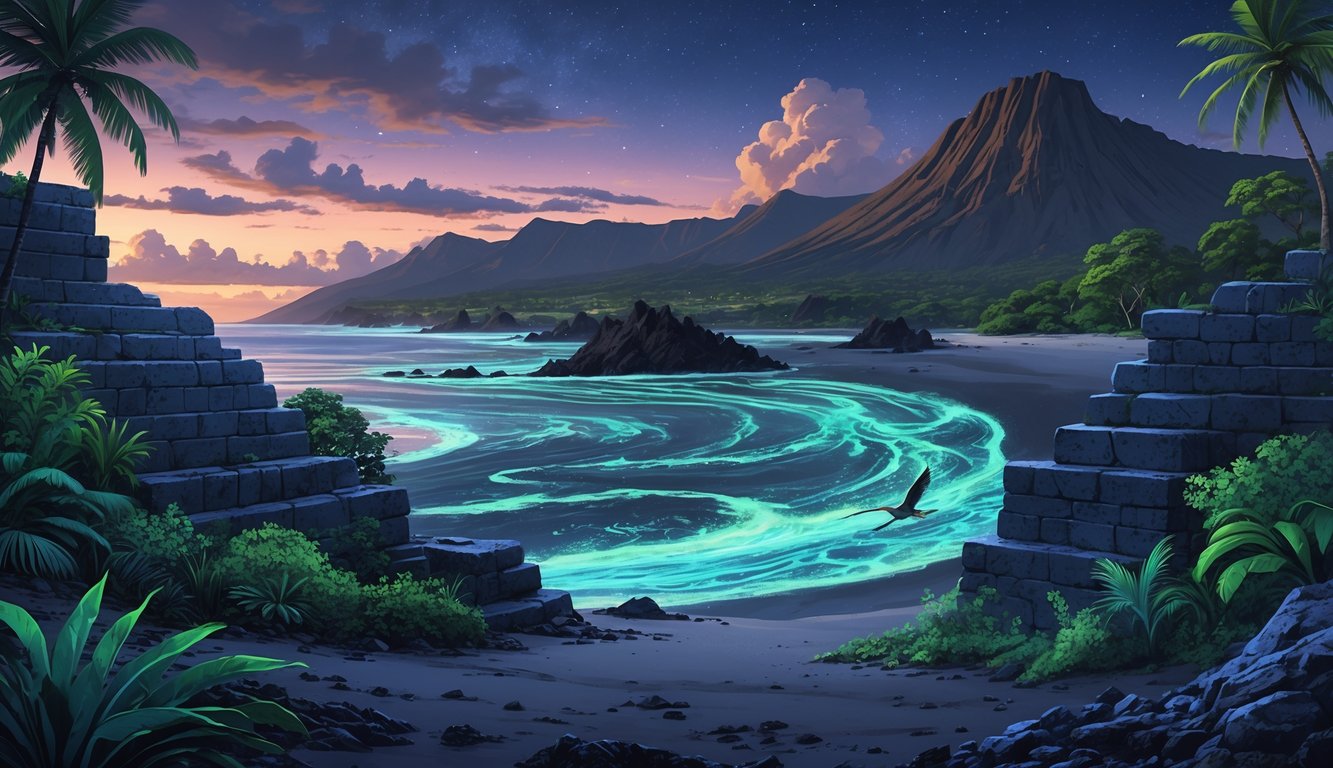
The Cabo Verde archipelago has many unusual places connected to both nature and history. Some islands have striking volcanoes, while others experience puzzling events linked to local weather and landscape.
The Volcanoes of Fogo and Maio
Fogo Island is known for its active volcano, Pico do Fogo, which rises to almost 2,829 meters. Locals tell stories about strange lights and rumbling sounds that sometimes happen before eruptions.
These signs have made the volcano a part of local legends and fears. The volcano’s eruptions have changed the shape of the island and the lives of people nearby.
Lava has destroyed villages and farms in the past, forcing many to move. Scientists study the volcano to understand how climate change may affect its future activity.
On Maio, volcanic activity is less dramatic, but the island has unique black sand beaches and old calderas. The contrast between quiet landscapes and sudden shifts in weather adds mystery to the island.
Visitors often say the volcanic terrain feels both beautiful and a little unsettling. For more on famous landmarks and volcanoes in Cabo Verde, visit this guide on landmark attractions.
Unexplained Natural Events
Some natural phenomena in Cabo Verde remain hard to explain. Sudden hailstorms and waterspouts sometimes appear even during dry months.
These rare weather events have puzzled scientists and locals for decades. Islands like Fogo and Maio have reported odd cases where animals act strangely before storms.
Flocks of birds sometimes leave an area hours before severe weather, possibly sensing changes in the air or pressure. Researchers are trying to find patterns in the weather data, but many questions remain.
The mix of ocean winds, volcanic grounds, and remote location keeps Cabo Verde’s weather mysterious.
The Search for Atlantis and Other Myths
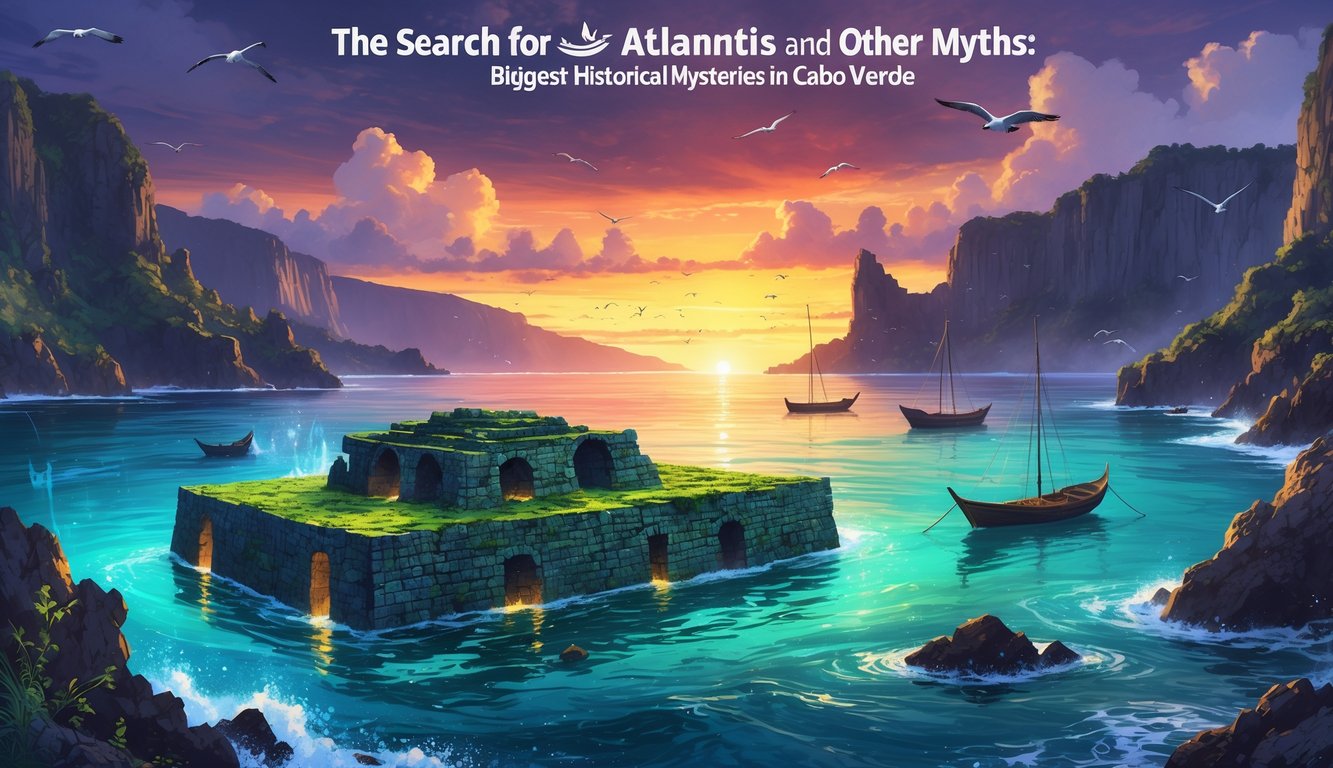
Some legends in Cabo Verde are tied to ancient stories and mysteries that reach beyond the islands. Tales of lost cities like Atlantis and local myths shaped by African and European roots fill the region’s history.
Atlantis Theory and Cabo Verde
The idea of Atlantis—a lost city described by Plato—has fascinated people for centuries. Cabo Verde, a group of islands off the coast of West Africa, sometimes appears in debates about possible real-world locations for this mythical place.
Some explorers and writers suggest that Cabo Verde’s position in the Atlantic, far from Europe but close to Africa, fits certain theories about Atlantis’s location. Ancient maps and sea routes show that these islands could have been reachable in early history.
No real evidence links Cabo Verde to Atlantis, but its unique location often raises questions in TV specials and books. Shows like History’s Greatest Mysteries have explored the possibility of Atlantis near Cabo Verde, sparking local curiosity (see History’s Greatest Mysteries: The Search for Atlantis).
Myths Blending African and European Influences
Cabo Verde’s myths have many sources. The Portuguese settled the islands in the 1400s, bringing European stories and beliefs.
African influence—through people brought by trade and migration—helped shape local legends. African spirits, gods, and folk tales merged with European myths about the sea, storms, and lost cities.
Special stories grew about mysterious islands, hidden treasures, and strange beings living between land and water. Cabo Verdean tales often borrow from both worlds.
Some islanders speak of sea monsters, a theme found in African water spirits and European sailor stories. This blend gives Cabo Verde a rich storytelling culture, connecting it to both continents through myth and history.
Colonial Intrigue and the Path to Independence
Cabo Verde’s journey from colonization to independence is filled with untold stories. These stories include political secrets, life under Portuguese rule, and the struggle by local movements for freedom.
Secret Deals During Colonial Rule
The Portuguese colonized Cabo Verde in the 15th century. The islands served as important stops for Atlantic trade routes and played a key role in the slave trade.
Colonial officials made secret agreements to control land, labor, and resources. Some Portuguese rulers traded favors for loyalty among local chiefs and merchants.
These backroom deals helped the Portuguese maintain control but often caused hardships for ordinary people. During droughts and famines, local leaders sometimes bargained secretly to secure scarce food from the authorities.
This system allowed a few to gain power while most people struggled. Efforts to resist such exploitation later inspired movements that pushed for independence.
Salazar’s Portugal and Cabo Verde
Portugal’s leader António Salazar enforced tough colonial policies, especially after World War II. The regime limited rights and tightly controlled education, speech, and travel.
Most profits from economic activities went back to Portugal. Salazar’s government ignored calls for local self-rule, even as other African colonies moved toward independence.
People in Cabo Verde faced long periods of poverty and hunger under these harsh rules. Secret police, known as PIDE, watched anyone seen as a threat.
Political dissent was not tolerated, which made organized resistance slow to grow at first. These conditions increased anger and the desire for change across the islands.
PAIGC, PAICV, and the Fight for Freedom
By the 1950s and 1960s, organized groups began to push back. Amílcar Cabral and others formed the African Party for the Independence of Guinea and Cape Verde (PAIGC) to challenge colonial rule.
They organized protests and fought for self-determination. After years of activism, the struggle spread.
When Guinea-Bissau won independence, Cabo Verde’s movement gained momentum. The African Party for the Independence of Cape Verde (PAICV) then focused solely on the islands.
These groups negotiated for freedom instead of waging large-scale armed conflict. On July 5, 1975, Cabo Verde declared independence from Portugal, ending centuries of colonial control and starting a new era of self-rule.
To learn more about the independence journey, see how local parties shaped the nation.
Hidden Stories of Cabo Verdean Culture and Identity
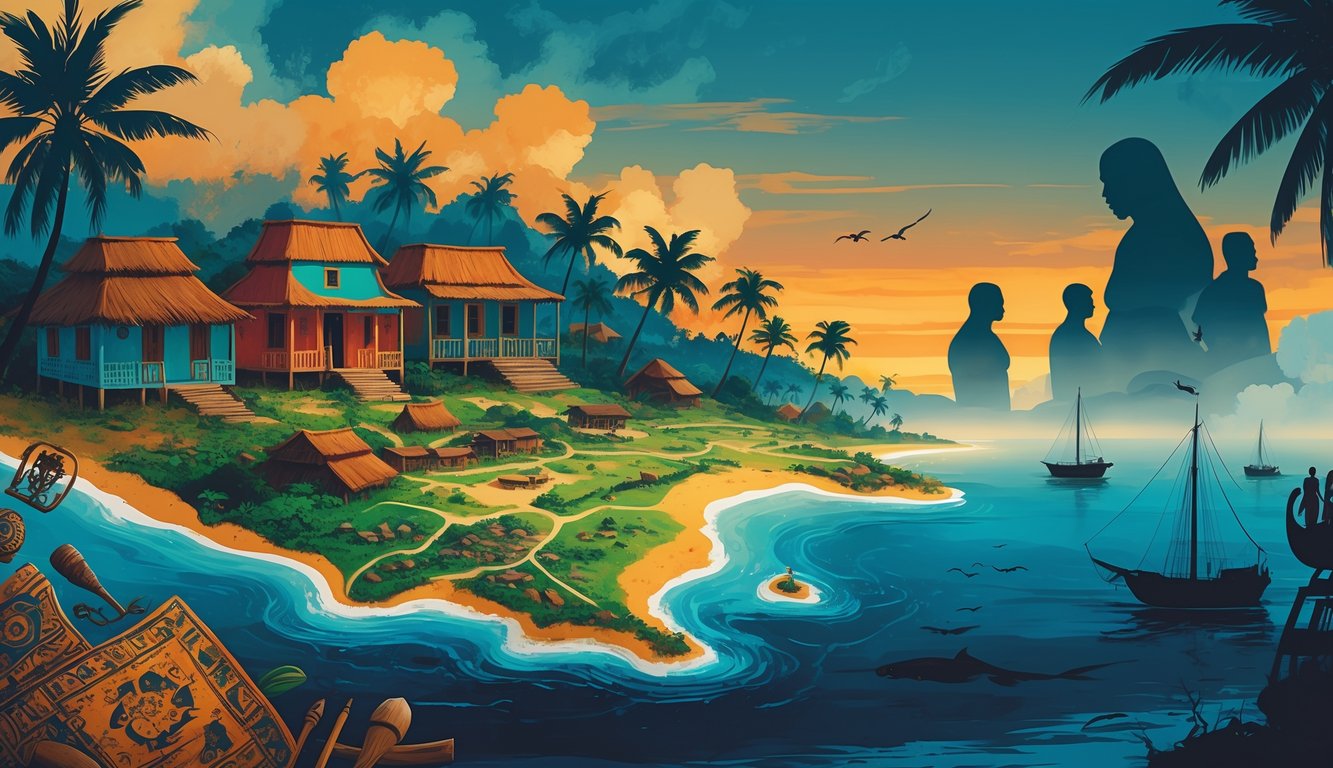
Cabo Verde has a distinct history shaped by a blend of African and European heritage. Its language, music, and cultural identity show deep connections to both continents.
Roots of Creole Culture (Kriolu)
Cabo Verde’s creole culture, known as Kriolu, developed from the mixing of African and Portuguese peoples over centuries. This blend appears in language, family traditions, and daily community life.
Kriolu is more than a dialect; it is a symbol of identity that unites people. It uses words from Portuguese and African languages, creating a style unlike any other.
Today, people speak Kriolu in homes, schools, and music. It represents pride and the resilience of Cabo Verdeans.
Customs such as storytelling, traditional crafts, and food show the ongoing influence of both worlds. This makes Cabo Verdean culture truly unique.
The Influence of Batuque and African Music
Batuque is one of the oldest music and dance traditions in Cabo Verde. Enslaved African women started Batuque as a way to communicate, celebrate, and share stories through rhythm and movement.
Performers use drums made from local materials. Songs and dances often talk about daily life, hardship, and hope.
Batuque’s beats and call-and-response singing style show clear African influence. This tradition formed the base for many other Cape Verdean music styles.
Modern musicians keep Batuque alive and mix it with styles from Europe and other African countries. Batuque plays a key part in the islands’ cultural heritage and identity.
The Enduring Legacy of Cesária Évora
Cesária Évora, known as the “Barefoot Diva,” is one of Cabo Verde’s most famous artists. She grew up in Mindelo and used music to share the sounds and feelings of her country with the world.
Her songs use Kriolu and tell stories about love and longing. Évora’s style, morna, is slow, emotional, and deeply rooted in both African and Portuguese traditions.
Cesária Évora won international awards and toured the world. She brought attention to Cabo Verde’s unique music and culture.
She inspired young artists and showed the importance of sharing Cabo Verdean identity with global audiences. Her legacy continues to shape music and national pride in Cabo Verde.
Modern Mysteries: Emigration, Development, and Diaspora

Cabo Verde’s history raises questions about how people, jobs, and opportunities have moved across borders and oceans. Its changing economy and global links present new questions for historians and locals.
The Massachusetts Connection
Emigration has shaped Cabo Verde’s history for over a century. One of the most interesting parts is the strong tie between the islands and Massachusetts.
Many families left for New England, often working in fishing or factories. It is still not clear why Massachusetts became such a popular choice, though some Cape Verdeans arrived there on whaling boats as far back as the 1800s.
Today, the diaspora in Massachusetts is one of the oldest and largest Cape Verdean communities outside Africa. Remittances sent back home continue to help Cabo Verde’s economy.
The impact of this close bond on culture, language, and development keeps historians asking how both places have shaped each other.
Mysteries of Economic Diversification and Growth
Cabo Verde has worked to move beyond its colonial past and dependence on a few crops. Economic development remains a challenge for an island nation with scarce resources.
The government has invested in services, renewable energy, and trade to diversify the economy. But results are mixed, and some industries, like information technology or large-scale agriculture, have not grown as expected.
Unemployment and underemployment remain high, especially among young people. External shocks, such as global trade changes and climate effects, can slow growth.
Researchers continue to ask how Cabo Verde can create stable jobs and reduce reliance on foreign aid and remittances.
Tourism’s Unforeseen Effects
Tourism is now a top source of income in Cabo Verde. The white sand beaches and warm climate attract thousands of visitors each year.
However, many people question the real impact of tourism on local communities. Foreign companies own many tourist resorts and use imported goods.
This situation limits how much money stays in the country or benefits small businesses. Some worry that heavy tourism could threaten traditions and weaken local culture.
Others ask if tourism can create long-term jobs that support local families. Cabo Verdeans, government leaders, and observers continue to debate how to balance growth and protect local ways of life.
Lesser-Known Historical Puzzles of Cabo Verde
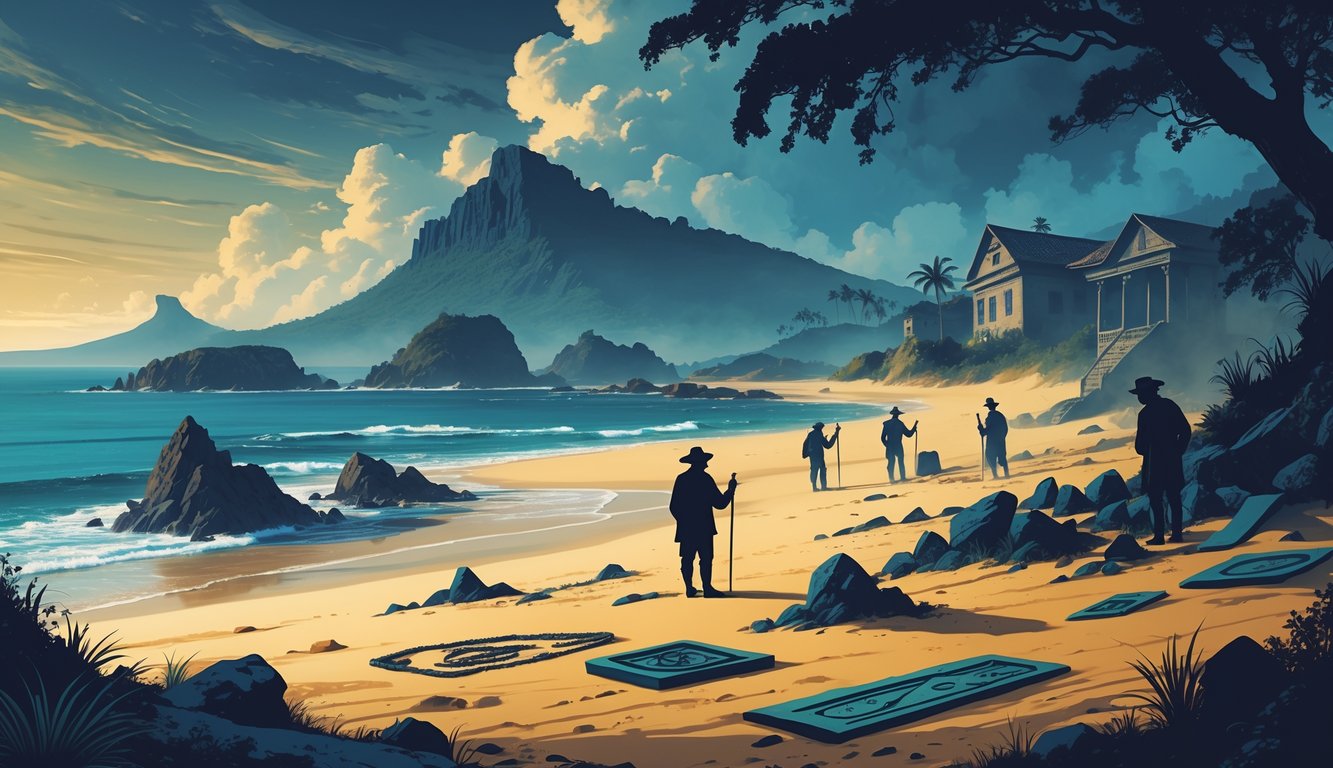
Cabo Verde’s history holds secrets that historians are still trying to solve. Stories of seafaring, island settlements, and changing governments add depth to the nation’s past.
Enigmas of Whaling and Maritime Activity
Whaling played a surprising role in the early days of Cabo Verde. American and European ships often stopped at the islands for fresh water, supplies, and crew.
Historians still do not know how closely local people worked with these ships or how whaling changed the islands’ ways of life. Some records show Cabo Verdeans joined whaling trips and settled in places like New England.
Questions remain about how this movement affected the culture and economy of the islands. Details—such as the number of people involved and the social effects—are hard to pin down.
Key mysteries include:
- How many locals joined international crews?
- What was the true economic impact on families?
- Did whaling lead to long-lasting changes in island life?
Unsolved Questions about Boa Vista and Santiago
Boa Vista and Santiago are two of the most important islands historically. Much about their early communities is still unknown.
Archaeologists and historians continue to search for clues about how people first settled these islands after the Portuguese arrived in the 15th century, when Cabo Verde first became inhabited.
Boa Vista holds ruins and artifacts from its salt and cotton trade. Experts debate how these industries shaped migration and cultural mixing.
On Santiago, Cidade Velha is famous for its transatlantic slave trade. Mysteries linger about everyday village life and the social roles slaves played outside the main town.
Researchers still search for answers about how the islands’ ecology, trade, and peoples combined to build such unique communities.
Education, Health, and Political Stability in Transition
Transitions in education and health have shaped Cabo Verde’s development. Periods of political change played a key role in these shifts.
The journey from colonial rule to independence affected local schools and medical systems in unexpected ways. Later, the move to multiparty democracy brought more changes.
During the 1900s, the nation’s government improved access to education. Leaders also began tackling health issues such as malaria.
Many records and reports on the quality of early school systems and medical care are missing or vague. The rise of the Movement for Democracy in the 1990s brought new reforms aimed at stability.
How these changes affected regular families is still debated.
Quick Facts Table:
| Period | Main Change | Mystery |
|---|---|---|
| Pre-independence | Colonial education, limited access | How effective were schools? |
| Independence-1990 | Health campaigns, new policies | Impact on rural communities unclear |
| 1990s onward | Democratic reforms, political shifts | Real effect on stability under-studied |



